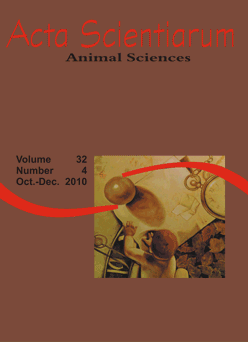<b>Characteristics and yields of carcass and cuts in Santa Ines sheep fed with different concentrations of metabolizable energy</b> - doi: 10.4025/actascianimsci.v32i4.9684
Keywords:
Concentrate, primal cuts, small ruminants, roughage
Abstract
This study evaluated the weight gain (ADG), feed conversion (FC), feed efficiency (FE), characteristics of carcass and retail cuts of Santa Inês sheep fed different levels of metabolizable energy (2.08, 2.28, 2.47 and 2.69 Mcal kg-1 of DM). Twenty lambs, with age and mean body weight of 50 days and 13 ± 0.56 kg, respectively, were distributed in randomized block design with five replications. We verified a linear increase effect (p < 0.05) on the ADG. The loss at fasting, FC, FE, hot and cold carcass dressing, as well as the weight loss by cooling were not affected (p > 0.05) by the energy levels of the rations. Nevertheless, the weights of hot and cold carcass and theempty body , expressed in kg, presented quadratic effect (p < 0.05), as we increase the levels of metabolizable energy in experimental diets. The energy levels influenced the yield of rib and shoulder, as the loin eye area (p < 0.05). In conclusion, the manipulation of the energy level of the ration changes the ADG, the hot and cold carcass weight, the shoulder yield, the rib weight and the loin eye area of Santa Ines sheep.Downloads
Download data is not yet available.
Published
2010-10-22
How to Cite
Pereira, E. S., Pimentel, P. G., Fontenele, R. M., Medeiros, A. N. de, Regadas Filho, J. G. L., & Villarroel, A. B. S. (2010). <b>Characteristics and yields of carcass and cuts in Santa Ines sheep fed with different concentrations of metabolizable energy</b> - doi: 10.4025/actascianimsci.v32i4.9684. Acta Scientiarum. Animal Sciences, 32(4), 431-437. https://doi.org/10.4025/actascianimsci.v32i4.9684
Issue
Section
Animal Production
DECLARATION OF ORIGINALITY AND COPYRIGHTS
- I Declare that current article is original and has not been submitted for publication, in part or in whole, to any other national or international journal.
The copyrights belong exclusively to the authors. Published content is licensed under Creative Commons Attribution 4.0 (CC BY 4.0) guidelines, which allows sharing (copy and distribution of the material in any medium or format) and adaptation (remix, transform, and build upon the material) for any purpose, even commercially, under the terms of attribution.
Read this link for further information on how to use CC BY 4.0 properly.
0.9
2019CiteScore
29th percentile
Powered by 








































